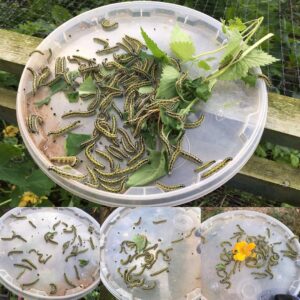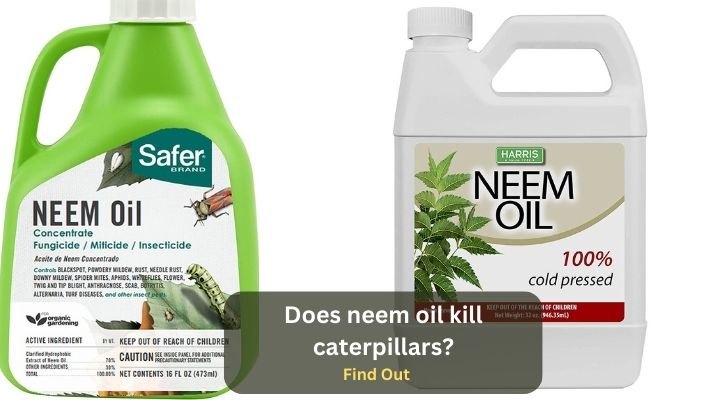One of the most common pests that gardeners encounter is caterpillars. These small, crawling creatures can wreak havoc on our plants and crops, causing significant damage. While there are several ways to control caterpillars, one question that often arises is whether neem oil is an effective solution.
Neem oil is an essential oil extracted from the seeds of the neem tree (Azadirachta indica). Neem oil has many insecticidal, fungicidal, anti-inflammatory, and antiseptic properties. It also inhibits fungal growth and bacterial growth, But does it work in killing caterpillars?
Neem oil is a fantastic plant-care product that can enhance your plants’ health and help them grow. It’s also a very safe pesticide, so you can use it on your plants as often as you like.
It is usable on vegetables, fruits, and other plants to prevent insect infestations. It can also be used to control aphids and powdery mildew on houseplants. Let’s take a closer look at the science behind neem oil and its effectiveness in controlling caterpillars.
How neem oil kills caterpillars
Neem oil is a natural remedy that can be used to kill caterpillars. Pure Neem oil contains a chemical called azadirachtin, which is toxic to insects and has been shown to affect caterpillars. The chemical works by blocking the insect’s nervous system, causing it to stop moving and die.
The neem oil acts as a neurotoxin, which causes the caterpillar’s nerves to malfunction and ultimately kills it. It is also effective against many types of pests, including earwigs and aphids—so you don’t have to worry about killing your plants.
Ready-to-use neem oil can be found at most garden centers and nurseries, or you can make one yourself. You should apply the oil directly onto the caterpillar’s body, where it will quickly sink into its body cavity and die.,
In fact, neem oil was so effective at killing caterpillars that farmers used it to prevent them from eating their crops. It worked so well that farmers would apply neem oil to their fields before planting them to keep pests and other caterpillars away until harvest time which could be several months away.
How to use Neem oil to kill caterpillars
Neem oil will kill caterpillars on contact by smothering them or by making them dehydrate and die, and it won’t harm plants. In fact, neem oil can help plants grow bigger and stronger because of how well it protects them from pests such as caterpillars.
There are many ready-to-use neem oils in the market, and you can make your own. It is best not to use the full amount of neem oil since it can damage plants, but instead, dilute it with water until you get the desired concentration.
To use neem oil to kill caterpillars:
- First, ensure you use high-quality neem oil for insect control. You can find this at most garden supply stores or online.
- Mix 2 tablespoons of neem oil with quarts of water (4 cups) and a teaspoon of dish soap. You’ll want to ensure you don’t mix too much water or too little, just enough to cover the area where you’re spraying your plant. (you a tablespoon of dish soap)
- Spray the solution onto your plant’s leaves and stems, ensuring that all surfaces are covered for maximum effectiveness. Make sure to spray the undersides of leaves and the areas where the caterpillars are feeding.
- Repeat the treatment: Neem oil is not a quick fix. You may need to reapply the neem oil every 7-14 days or as needed until the caterpillars are gone.
This solution should not be applied while it is sunny; it should be applied early in the morning or late in the afternoon to prevent leaf burning.
The oil has many benefits for plants, including:
- It repels aphids and other insects
- It helps protect plants against disease
- It can be used to treat fungal infections
How often should you use neem oil?
Neem oil is a natural supplement used to treat many diseases and conditions but can be dangerous when overused on plants.
Neem oil works by killing parasitic fungi and bacteria that cause damage to crops. The active ingredient in neem oil is azadirachtin, extracted from the bark of a neem tree native to India.
You can use neem oil once a week to get rid of pest infestation or once every 2 or 4 weeks to prevent your plants from spreading disease. However, keep your solution away from sunlight to keep it effective.
If you want to ensure your neem oil is potent and effective, store it in the refrigerator. You can also keep it in the dark cupboard or pantry.
Are there any side effects of using neem oil?
Neem is a plant-derived insecticide and fungicide that has been used for centuries as a natural pest control method. It’s safe for humans and animals but can adversely affect your plants if you’re not careful.
Here are the most common side effects:
- Blotchy spotting: This is caused by the leaves turning a bright green or yellow color and then falling off due to damage from the oils. To prevent this, try to use less neem oil.
- Bacterial infections: If you notice spots on your plants that look like they’re infected with bacteria, this could be due to the presence of neem oil in your soil. Try switching to another type of fertilizer or ensuring your soil is well-drained before adding any nutrients so they don’t become trapped under the leaves.
- Lack of foliar feeding: some plants may not be able to take up enough nutrients through their leaves when they’re exposed to too much neem oil. If this happens, try applying less than what’s recommended during each watering cycle until
Other natural ways to get rid of caterpillars on plants
There are a variety of other methods you can try that don’t involve harsh chemicals. Let’s take a closer look at some of these natural ways to get rid of those pesky caterpillars.
Use Other Organic Pesticides
Organic pesticides include pyrethrum and carbaryl. They are also called botanical insecticides. These organic pesticides are safe for humans to use around the house and garden without worry, but they must be applied with care so as not to damage edible plants or cause harm to the person handling them.
Some organic pesticides can be used directly on plant leaves and stem without harming those plants; others require that they be mixed into the water before being sprayed on plants and then watered into the soil where caterpillars live.
Handpicking
Another natural way to get rid of caterpillars on plants is through handpicking. While it may be time-consuming, removing these pests from plants is an effective method. You can wear gloves to avoid direct contact with the caterpillars because some may be itchy.
It is more effective than any other method mentioned above because it allows you to carefully check for caterpillars o the plants and pick them up one by one with a pair of tweezers.

It’s best to do this in the morning or evening when the caterpillars are more active. Remember to dispose of them properly, so they won’t crawl back onto the plants.
This method is also environmentally friendly and doesn’t involve the use of any harmful chemicals. Additionally, it allows you to closely monitor the health of your plants and prevent further infestations.
Use diatomaceous earth
Diatomaceous earth is a fine powder made from microscopic sea creatures called diatoms that have been ground into a powder form. Diatomaceous earth can be used as an organic pesticide for pest control when mixed with water in a spray bottle.
Simply mix 1/2 cup of diatomaceous earth with 1 quart of water, shake well, and spray directly onto the leaves or stems of affected plants. Suppose you have larger areas that need to be treated with this product (such as entire gardens).
You may want to dilute it by mixing 1/2 cup of diatomaceous earth with 2 gallons of water before spraying on your plants.
Companion planting
Another effective natural way to eliminate caterpillars on plants is through companion planting. This involves planting certain plants that attract insects that prey on caterpillars, such as ladybugs, lacewings, and parasitic wasps.
Examples of plants that are good companions for this purpose include marigolds, dill, and fennel. Creating a diverse garden with various plants can encourage a healthy ecosystem that keeps pests in check.
In addition to deterring caterpillars, companion planting can also improve soil health and promote pollination. Overall, it’s a great way to protect your plants without resorting to harmful chemicals.
Biological controls / Beneficial insects
Another approach is to use biological controls, which are natural enemies of caterpillars that can help keep their populations in check. These can include things like parasitic wasps, nematodes, and bacteria that specifically target caterpillars.
Another approach is to introduce beneficial insects to your garden. These can include predators like ladybugs, lacewings, and praying mantises, which will happily feed on caterpillars and other garden pests. You can purchase these insects online or from your local garden center and release them in your garden as needed.
Overall, both of these methods can be effective at controlling caterpillars without the use of harmful chemicals. Remember to research and ensure you’re using the right approach for your specific plant and pest problem. With a bit of patience and perseverance, you can protect your plants and enjoy a healthy, pest-free garden.
Attracts Predators
Many birds, insects, and animals feed on caterpillars, so creating a habitat welcoming to these predators can help control the caterpillar population.
Birds and amphibians are some of the most beneficial creatures on Earth. Not only do they help to keep insect populations down, but they also eat caterpillars that might be damaging your plants.
Planting certain flowers and herbs can attract beneficial insects like ladybugs, lacewings, and parasitic wasps that prey on caterpillars. You can also encourage birds to visit your garden by providing them with nesting boxes and bird feeders.
Another way to attract predators is to create a diverse garden with various plants. This will provide a habitat for various insects, birds, and animals that can help keep caterpillar numbers in check.
Conclusion
neem oil is an effective natural insecticide that kills caterpillars and other pests. It works by disrupting their feeding and breeding habits, causing them to starve and die.
However, the efficacy of neem oil may vary depending on the type of caterpillar and the concentration and application of the oil. Therefore, following the instructions carefully and using neem oil in conjunction with other pest control methods for optimal results is essential.
Ultimately, if you are looking for an eco-friendly and safe way to control caterpillars in your garden, neem oil is a viable option that deserves consideration.


